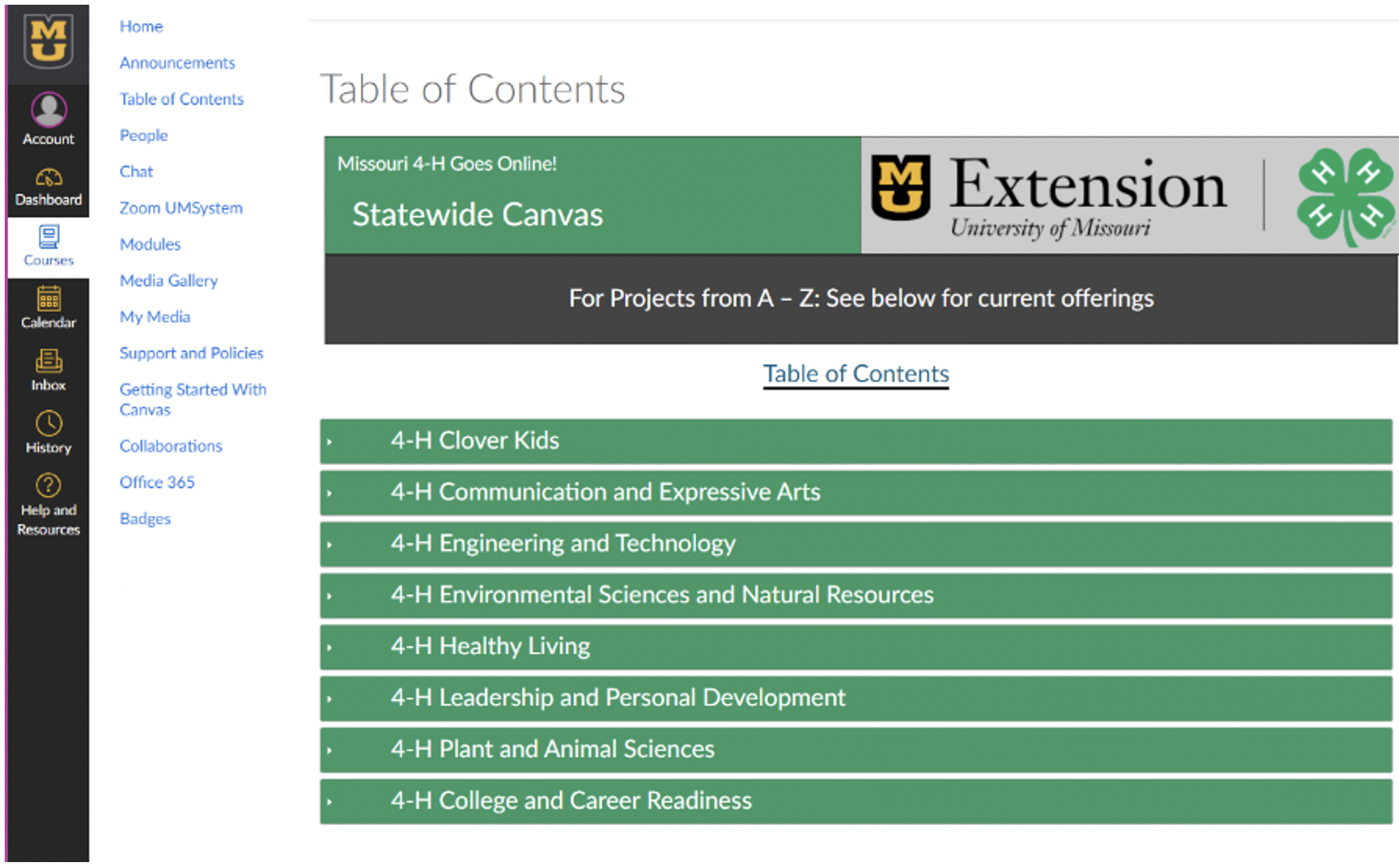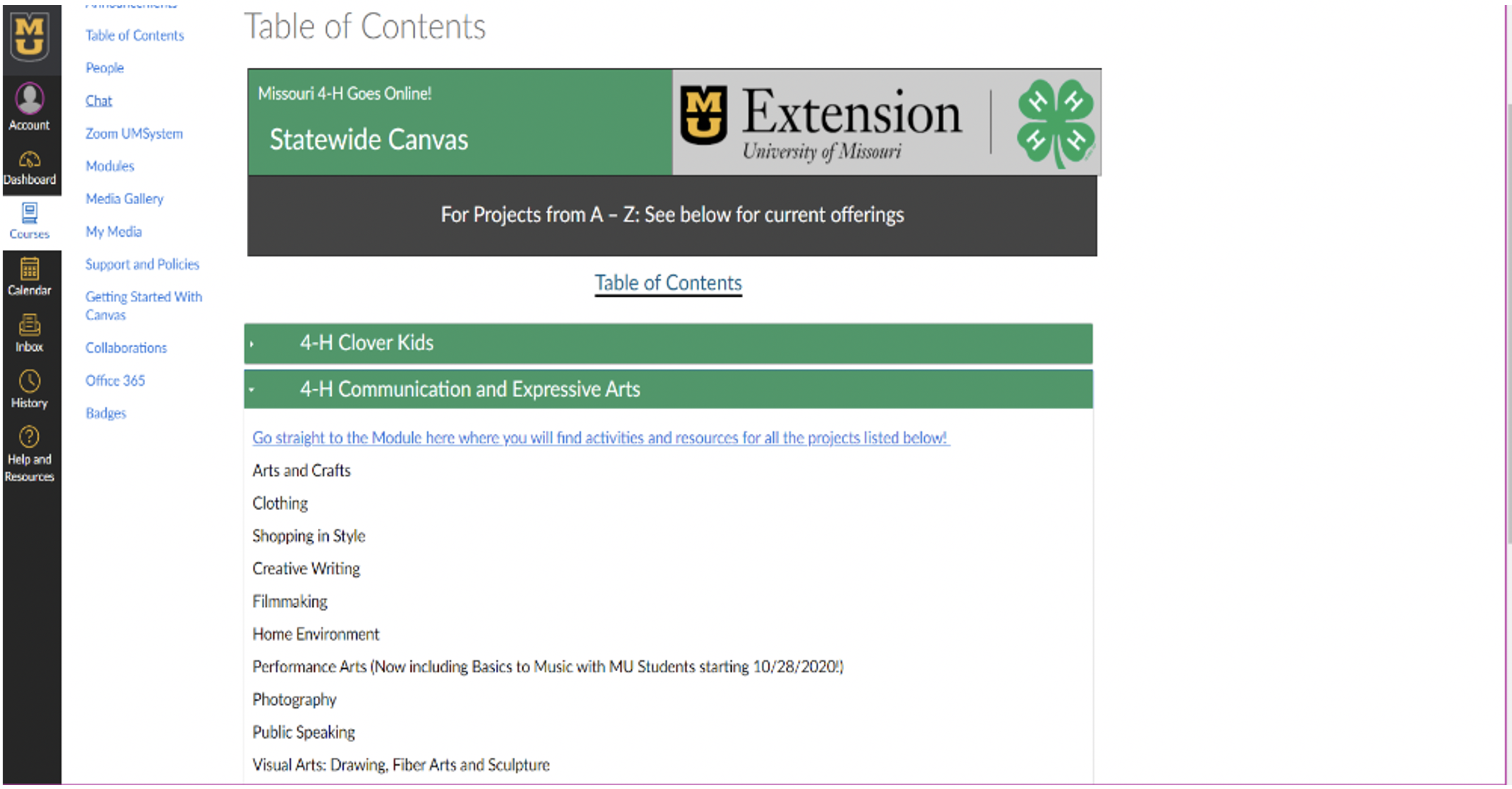 |
December 2020
|
December 2020 // Volume 58 // Number 6 // Tools of the Trade // v58-6tt4
Using Learning Management Systems to Provide 4-H Programming During the COVID-19 Pandemic and Beyond
Abstract
Using a learning management system (LMS), such as Canvas, to provide 4-H programming can support program growth. With the onset in 2020 of the COVID-19 pandemic, 4-H professionals have been forced to move face-to-face activities online and challenged to work differently and in innovative ways to continue offering youth development opportunities. Responding to this challenge, Missouri 4-H created an online resource using the Canvas LMS to offer 4-H volunteers and families project opportunities and research-based project materials in one easily accessible and affordable platform.
Introduction
Using a learning management system (LMS) to provide 4-H programming during the COVID-19 pandemic supports 4-H by meeting constituency needs and fostering program growth. In March 2020, University of Missouri Extension, with many Extension programs nationwide, closed offices and canceled face-to-face activities due to the pandemic. Offices closed and 4-H professionals began working from home, making it difficult for youths and families to access traditional resources. Even so, 4-H professionals understood that reaching youths and families was their highest priority during this time (Arnold, 2020; Arnold & Rennekamp, 2020).
Traditionally, the Missouri 4-H Center for Youth Development has supported volunteers and families with an online and paper publication called 4-H Clover. This annual publication includes enrollment and event information as well as information related to project skill areas with links to purchasable curriculum. 4-H faculty and staff use 4-H Clover as a project guide and recruitment tool for volunteers and families. Once a volunteer reviews 4-H Clover and accepts the role of leading a project, the next steps are for the volunteer to purchase the associated research-based curriculum and host project meetings for families.
The need for 4-H to offer online resources such as the online version of 4-H Clover existed before the pandemic. However, the onset of the pandemic exacerbated the need for volunteers and families to switch to an online world, and we in 4-H have needed to show leadership online in the same way we always have offline (Light & Falkenthal, 2013). To this end, Sarah Morefield identified a solution for effectively offering project information, curricula, and activities to Missouri 4-H volunteers and families: use of an LMS. In a matter of weeks, the endeavor expanded from one county to a statewide effort. Herein we describe how Missouri 4-H is using Canvas to support 4-H volunteers and families by providing research-based resources.
Use of Canvas
Ideally, volunteers and families purchase research-based project books from 4-H. However, more often than we like to admit, volunteers google 4-H project topics and access resources from sites such as Pinterest, Teachers Pay Teachers, and others showcasing educational activities. To implement the idea of providing project information and resources via an LMS, we chose Canvas due to its flexibility and availability at the University of Missouri. Through use of Canvas, we are able to provide 4-H volunteers and families easy access to research-based materials for 4-H project areas for an annual fee of $5. As well, although many learning platforms exist, it has been shown that Canvas increases learners' achievement potentially by a greater percentage than other learning platforms offered (Yana, 2018).
Canvas is a web-based LMS used by higher education institutions, educators, and students to access and manage online course learning materials and communicate about skill and learning achievement. Canvas's many features include virtual meeting places, public and private discussion boards, and functions for creating a stairstepped learning experience (Canvas Doc Team, 2020). Also, Canvas offers resources and materials that can be used for online or offline learning and that can be accessed on mobile devices by communities with limited broadband via the Canvas Student app.
Through Canvas, Missouri 4-H can provide sequenced 4-H projects and activities. 4-H professionals and volunteers can add content and interact with other users. Simultaneously, other staff and faculty with observer access can stay informed on project happenings. One 4-H faculty member manages access and registrations for 4-H volunteers and families. Having one platform where all information is provided simplifies 4-H processes. Furthermore, we can promote use of the Missouri 4-H Canvas page by community and school partners, helping us bring 4-H projects to such organizations and potentially allowing us to reach new audiences.
Design of the Missouri 4-H Canvas Page
The design of the Missouri 4-H Canvas page is simple and user friendly. 4-H volunteers and families register in Canvas through 4-HOnline. They receive a URL to use for creating a profile and logging in to the Missouri 4-H Canvas page. After logging in, a user is directed to a table of contents comprising the category headings used in 4-H Clover (Figure 1). Below each category heading are a link to the module page for that project category and a list of projects that are "live" online in that project category (Figure 2). Each project category has assigned lead instructors who help ensure resource quality by integrating content knowledge with appropriate youth development materials.
Figure 1.
Missouri 4-H Canvas Table of Contents

Figure 2.
Category Heading, Project Module Link, and List of "Live" Projects for Communication and Expressive Arts Project Category on Missouri 4-H Canvas Page

Project module pages are identical in structure. A project module page is where users access project materials (Figure 3). All headings are formatted with an accordion feature so that the user can avoid an abundance of scrolling to find the resources needed. At the bottom of each project module page is a link directing the user back to the table of contents.
Figure 3.
Project Materials Links for Visual Arts—Painting, Printing, and Graphic Designs Projects on Missouri 4-H Canvas Page

Evidence of the need for an online learning platform was confirmed through registrations occurring quickly after the platform was made available October 1, 2020. In 12 days of open registration, 40 volunteers/families enrolled. Immediate feedback from Missouri 4-H volunteers included comments such as this:
So much there to explore. I think this is going to help so many families get the resources to make it a great year. We have had a hard time finding leaders locally for many projects and I have volunteered for many projects and stumbled through. This is going to help us so much!
Lessons Learned
In planning and implementing the use of Canvas as a central resource for Missouri 4-H project information and materials, we gleaned the following lessons:
- There is a need to offer research-based projects through online learning platforms to 4-H volunteers and families.
- Missouri 4-H provides a viable and versatile alternative through Canvas to support volunteers and families with research-based resources.
- For areas with limited broadband access, Canvas is practical because resources and materials can be used online and offline and can be accessed from mobile devices via the Canvas Student app.
- Using Canvas for an annual $5 fee does not cause an economic burden for most families involved in Missouri 4-H.
- Use of Canvas as a learning platform for 4-H has proved effective during the COVID-19 pandemic and could be implemented by those at other land-grant universities to deliver Extension programming for the duration of the pandemic and beyond.
Author Note
We thank Missouri Extension Clay County 4-H staff, including Brenda Brinkhous-Hatch, Matilian Cassmeyer, Lizette Macedo, and Chris Morales, as well as numerous University of Missouri–Kansas City/University of Missouri student interns for helping get our project off the ground in March 2020. We also thank Sherry Grace and Chelsea Corkins for their contributions to the marketing and media graphics used for promoting the 4-H Canvas page as well as the lead instructors and the University of Missouri campus Canvas team, including Bradd Anderson, Ty Peckman, Amanda Meek, Maria Calvert, Samantha Brandeberry, Velynda Cameron, Michael McIntosh, and Jessie Gordon.
Correspondence concerning this article should be addressed to Sarah Morefield. Email: morefieldsa@missouri.edu
References
Arnold, M. E. (2020). America's moment: Investing in positive youth development to transform youth and society. Journal of Youth Development, 15(5), 16–36. https://doi.org/10.5195/jyd.2020.996
Arnold, M. E., & Rennekamp, R. A. (2020). A time like no other: 4-H youth development and COVID-19. Journal of Extension, 58(3), Article v58-3comm1. https://www.joe.org/joe/2020june/comm1.php
Canvas Doc Team. (2020, October 17). What is Canvas? https://community.canvaslms.com/t5/Canvas-Basics-Guide/What-is-Canvas/ta-p/45
Light, M., & Falkenthal, J. (2013). Positive youth development in the 21st century: Exploring online environments. Journal of Youth Development, 8(1), 16–26. https://doi.org/10.5195/jyd.2013.104
Yana, D. (2018). The usage of Schoology and Canvas as media based blended learning. ANGLO-SAXON, 9(1), 82–91. http://dx.doi.org/10.33373/anglo.v9i1.1418




